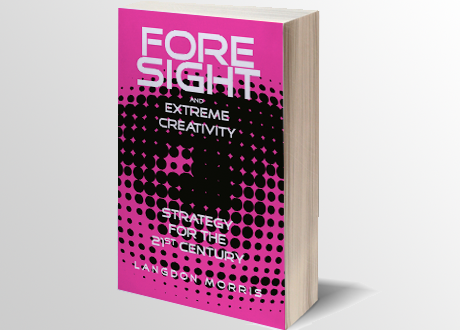By: Frank Mattes / Langdon Morris
Judging by experience, most top managers and innovators feel that they are in a maelstrom of change. For some, the rate of change and the magnitude of the consequences induced are so high that they feel a kind of ‘Present Shock’ – a term coined by Douglas Rushkoff, building upon Alvin Toffler’s concept of Future Shock, to describe the psychological impact that occurs when too much is happening simultaneously.
Just think about some of the happenings in business and societal structures where business is embedded, such as:
- Digital Transformation in developed countries
- Exponential growth in knowledge
- Global R&D shift to Asia
- Innovation and growth in developing / emerging markets
- Population growth and demographic shifts
- The first antecedents of global climate change
- Clear indications that the world’s consumption of resources is not sustainable
Albert Einstein once said, “if I had one hour to save the world I would spend 55 minutes on defining the exact problem.” What is missing in many instances is a framework for getting to the exact problem – and more so, defining meaningful, effective and actionable strategies.
This is exactly what Langdon Morris’s new book is about.
The book in a nutshell
Biologists classify humanity as a ‘super-predator.’ This is a new category that they had to invent specifically. No other creature in Earth’s history has proven to be so ruthlessly efficient at wiping out both its competitors and its prey.
However, humanity is not entirely immune from competition. It is more than a little ironic that humanity’s most dangerous competitor is … humanity.
Although the 20th century was the most violent in human history, the greater dangers that our species faces in the future may not be due to war, but due to commerce. In particular, with the advent of large scale climate change as a consequence of economic growth through the extraction and burning of fossil fuels.
Langdon’s book aims to declutter confusion and concern about the wave and ripple effects of future change—helping to see the underlying patterns and to structure future thinking.
It is addressed to leaders in all types of organizations who are concerned about these developments, both for-profit as well as non-profit organizations. It may also be of interest to individuals who are interested in how to manage a future which develops out of a present that seems chaotic and unpredictable.
Navigating the content
Langdon structures the huge amount of content and thinking into four parts:
Part 1 is about the six major revolutions that are shaping the world. In Langdon’s view these are:
In thinking about how to surf the waves of the tsunami of changes ahead and how to channel its breathtaking force, there is a decisive question to be answered…
- Digital / Technology
- Energy
- Climate
- Population / Urbanization
- Culture
- Counter revolution
Part 2 is about how humans deal with strategic thinking and strategy. Based on Darwin’s discovery, mankind should be the species that best adapts to a changing environment. Innovators have done this at all times by introducing something new to the world: In the light of Agile and Design Thinking, it has been the accepted way of exploring environmental niches by rapid testing and iteration. However, in thinking about how to surf the waves of the tsunami of changes ahead and how to channel its breathtaking force, there is a decisive question to be answered: Can this be done by rather small, iterative steps one at a time or is there a need for a grand strategic plan?
The answer is probably both. Scenario planning and deep strategic thinking must be complemented with sound decision making and timely responses to new events and discoveries.
Part 3 focuses on 3 key roles that are essential for success, clear thinking, innovation, and leadership. These are:
- The Philosopher
- The Innovator
- The Leader
Part 4 provides a ‘lexicon of tomorrow’ – Concepts and notions that will be relevant for thinking and discussing the future.
Original ideas
The book attempts to explain the broadest strategic perspective of world events and patterns. It is one of the few that makes a comprehensive argument about how the world is changing.
One of the many strong points in Langdon’s book is his observation that socio-economic systems which build on technologies that have an exponential growth in power and at the same time exponential decrease in cost per unit (e.g. computer processors) have continuing adoption and create compounding changes.
And contrary to popular opinion, Langdon shows very convincing evidence that the rate of population growth is declining rapidly, largely due to continuing urbanization, and that this is likely to lead to a significant economic crisis as the world’s population begins to age, but it could also be the basis for a very significant new economic model.
Analyzing the change from ‘more for me’ to ‘better for everyone’ provides valuable insight into how to navigate the future.
…uncertainty can be managed through a process he calls “disruption mapping.”
The book also shows in detail how to apply scenario planning to understand complex situations and provides many examples.
Langdon describes a very interesting process of innovation management in this concept of the cone of uncertainty, and shows uncertainty can be managed through a process he calls “disruption mapping.” He also describes the importance of innovation portfolio management and explains how business model innovations may be the most important in the coming era.
Specific relevance for innovators
Langdon discusses very real revolutions that are happening right now and which we actually see around us every day. Using real-world examples, Langdon clearly conveys the importance of the impacts that these revolutions are having on us today.
The book helps organizations to prepare for the future. For business leaders, it provides a framework for understanding many of today’s challenges and therefore helps in designing an innovation portfolio and the decision making and strategy that comes along with it.
Why you should read this book
Langdon Morris discusses with great depth what he calls ‘revolutions’—to summarize and categorize all the diverse ways technology, climate, population, conflict, energy, migration into urban centers, multiculturalism, etc. are shaping both the problem and solutions of tomorrow’s world today.
Even though this is considered to be a profound book, it is written in a way that can be understood by essentially anyone in any discipline. After reading it you begin seeing examples of the discussed revolutions in everyday matters in your own life.
It certainly is a challenging task to connect the dots. Langdon achieves this not only by delivering extensive data points that support his line of arguments, but also by utilizing the language of the future change-agents, the next generation. For instance, in discussing the sharp dichotomy between the haves and have-nots and a systemic practice of consumption and destruction, Langdon draws from Harry Potter and Yogi Berra.
Morris summarizes a call to action using both micro- and macro-spective strategies as a weapon to counter what may become a destructive state for the ‘super-predator’.
I highly recommend this book for anyone who has a serious interest in how our future cannot only be lived, but be shaped.
By Frank Mattes
About the authors
 Frank Mattes founded innovation.support and runs its business in the German-speaking countries. Frank Mattes has more than 15 years of experience in managing innovation, change management and projects. He has worked for several specialized medium-sized consulting companies and for The Boston Consulting Group. He also worked at C-level for an IT and a professional services firm. Frank also founded and runs innovation-3 which focuses on integrating cutting-edge innovation approaches into existing innovation management systems. Frank is the author of several books and a contributing editor to InnovationManagement.se, the number one platform for innovation management practitioners.
Frank Mattes founded innovation.support and runs its business in the German-speaking countries. Frank Mattes has more than 15 years of experience in managing innovation, change management and projects. He has worked for several specialized medium-sized consulting companies and for The Boston Consulting Group. He also worked at C-level for an IT and a professional services firm. Frank also founded and runs innovation-3 which focuses on integrating cutting-edge innovation approaches into existing innovation management systems. Frank is the author of several books and a contributing editor to InnovationManagement.se, the number one platform for innovation management practitioners.
 Langdon Morris, author of Foresight and Extreme Creativity has led the innovation consulting practice of InnovationLabs LLC since 2001, where he is a senior partner and co-founder. He is also a partner of FutureLab Consulting. He is recognized as one the world’s leading thinkers and consultants on innovation, and his original and ground-breaking work has been adopted by corporations and universities on every continent to help them improve their innovation processes and the results they achieve. His recent works Agile Innovation, The Innovation Master Plan and Permanent Innovation are recognized as three of the leading innovation books of the last 5 years.
Langdon Morris, author of Foresight and Extreme Creativity has led the innovation consulting practice of InnovationLabs LLC since 2001, where he is a senior partner and co-founder. He is also a partner of FutureLab Consulting. He is recognized as one the world’s leading thinkers and consultants on innovation, and his original and ground-breaking work has been adopted by corporations and universities on every continent to help them improve their innovation processes and the results they achieve. His recent works Agile Innovation, The Innovation Master Plan and Permanent Innovation are recognized as three of the leading innovation books of the last 5 years.

